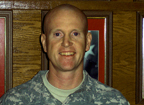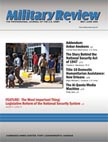An editor somewhere at the
New York Times should probably be very worried for his job right about now. Not because he or she missed a comma splice, or permitted a run-on sentence, that is actually the job of people called copy editors. No, that editor should be worried because today,
on page A1 and above the fold, he or she failed in their job to present a logical and intellectually coherent article. In short, they let a reporter run wild with an a historical collection of claptrap which displays both a stunning ignorance of the military as well as the even more unforgivable sin of being ignorant of how the Pentagon press corps (to include the Pentagon correspondent for the
Times) works.
Here is the short version of the thesis: The political appointees in the Pentagon try to counteract adverse news stories and also try to increase what they believe are positive news stories.
Whoa Nellie! Knocked ya right outta your saddle with that one, didn't they?
Of course, as with all such situations, there are some nuggets to be found within the body of the story. I will get to those in a minute. But as in other cases, be it the flights of fantasy engaged in by the Associated Press when they published their No Gun Ri story back in 1999, or the befuddled and confused musings of the quacks who would deny the Holocaust, or even the delusional belief of many military officers that it was the media, not the military, who lost Vietnam (Note: It was our fault. Us. In uniform. We failed in Vietnam. End Note.), the reporter for the New York Times takes factoids and spins them into a narrative just ripe for the Conspiracy Theorists of America, Inc.
Just look at the opening graphic. Somehow the NYT contends that Major General (Ret) Robert Scales is an administration cheerleader incapable of independent thought?! In what alternate reality is that true? Generals Montgomery Meigs and Barry McCaffrey? For Christ's sake, those are three of the most vocal and respected critics of the military conduct of operations that America has seen these past five years (though it should be noted that at least McCaffrey was initially in favor of the invasion). And yet the NYT wants to paint them as tools of the administration? Seriously? Folks, at least two of those generals have been invited panelists to speak before the House and Senate Armed Services Committees about the problems with the war. Invited by the Democrats mind you, not the Republicans. Seriously, somebody at the NYT headquarters needs to consider instituting a random drug testing program over there because the intellectual loops one has to tie oneself into to come to their thesis are worthy of Jayson Blair's style of "reporting."
Any hope that there might critical thinking vanishes in a cotton-candy poof of intellectual smoke when one realizes that the Times is seriously contending that we readers should believe that these retired generals and other officers were swayed by, well, see it yourself: "In interviews, participants described a powerfully seductive environment — the uniformed escorts to Mr. Rumsfeld's private conference room, the best government china laid out, the embossed name cards, the blizzard of PowerPoints, the solicitations of advice and counsel..."
Wait a second...you mean that the "participants" called it "powerfully seductive"? No, look closer, that word "described" means something. It means that they said no such thing and that the reporter is interpreting the scene for us plebians because, you know, we're not qualified on that count.
We should instead just take the reporter's word for it that men who just spent several decades dealing with all that same stuff as a course of their normal daily lives (the General Officer's mess in the Pentagon anyone?) are now suddenly "seduced" by "uniformed escorts" (ooooh, ahhhhh...such pretty uniforms, I am sooooo flattered), flatware and embossed cards. Oh, and I bet they were just bowled over by that new invention, the PowerPoint briefing. Bet none of them ever saw nuthin' like that.
What makes this even more disappointing is that the broader outlines of the thesis are not even really news. You see, when somebody writes a book about a topic, you cannot then pretend that book does not exist which covers the same material, or that you have found something all new...as the New York Times has now done. Retired Colonel and former-analyst Ken Allard wrote just such a damned book, several years ago. That is years. Not weeks. Not months. Years. It's called Warheads, and it is about the underside of being a military analyst. Now while Allard noted most of the points (but without the conspiracy theory spin) about interactions and connections, in his book, and is a source cited in the article in his own right...there is not so much as a hint about the fact that this is all, effectively, old information.
Hell, you can ask any historian and he'll take you back further. As one friend asked me, "When exactly did DoD PAO get into the 1984 business?" That would be 1947. Prior to that it was Department of War and Navy which did the same thing. And if you don't think FDR gave or withheld access? Or Wilson? Or Lincoln? You need to go back to school. All three most definitely tracked what was written and by whom, and granted or denied access on that basis...as did that feller Sherman (when he wasn't threatening to actually hang journalists), and Grant, and Pershing, and you can bet MacArthur did, and even Eisenhower tracked what journalists wrote, by name, and granted or denied access on that basis at times. (Most especially during the flare-up with His-Royal-Hineyness Montgomery of Alamein when the whole flap over "saving the Americans" appeared in the UK press in late Dec '44.) And let's not even get into Korea and Vietnam. So unless one is also "concerned" that this was wrong for Grant, Pershing, Eisenhower, etc., and that they were doing it wrong...
Now I am certainly not disputing that the Administration tries to spin America, and occasionally the world for that matter, like a Siamese kitten dropped into a Maytag. And I in no way dispute that they have tried to use friendly analysts to do so. I do not think that there is a reader out there who would be the least bit surprised that as the NYT put it, "many of them ideologically in sync with the administration's neoconservative brain trust." Hello? Homer Simpson has had more enlightening insights that that.
What I am disputing that it was propaganda for them to make the attempt. Look at the Creel Committee (aka the Committee for Public Information) circa 1917-1918. That, ladies and gentlemen, is propaganda. Look at some of the other things done during the Wilson Administration as well. This? No, this is about as surprising as POTUS giving repeated "exclusive" sit-down interviews to FOX News, and boxing out the other stations. It is also about as effective.
Indeed that is the unstated subtext of this story, and it is a pity nobody in the editorial offices of the New York Times picked up on the fact and gave that reporter a clue. You see the story is not that the current Administration tries to spin. All of them do that and none of us are surprised. The story is that this administration's public relations people are so completely incompetent at the effort. How do we know? Well, for starters look at public support for the war. But more importantly, go to the NYT site and look at some of the specifics of who the civilian appointees in the Office of the SecDef decided to invite, over and over...notice anything? FOX News, FOX News, FOX News...and that gang, is why the public affairs people in DoD and this Administration are about as successful at this whole "propaganda" thing as Charlie Brown on the first day of football season.
If your intent is to swing the public opinion which has turned against the war (or at various points, "was turning"), then hello, you have to talk to those people, the people who hold different opinions. You do not go forth with public appeals and "talking points" to the people who rabidly support your every bowel movement and seek justification for holding the TP whilst you wipe!
The bottom line is that somebody who watches FOX News gets the absolute LEAST war news (about 30% less as I recall), and is likely already completely ideologically committed to the Administration anyway, so it serves no purpose. (Something that the civilian political appointees in the OSD/DoD Public Affairs offices apparently have difficulty understanding.)
Now I stated at the outset that there is a nugget here, and that is the business ties aspect of the story, that's legit. To a degree. But at the same time you don't see when a legal consultant is on the air, or a medical one, the depth of their ties to their own industries. The interlocking of the board memberships is also a bit problematic, and I think full disclosure on those points should have been made by the analysts. But then again, if the news organizations did not ask (or even inform/educate about the standards of journalism) their analysts the questions about their business connections, how were the retirees supposed to know about the journalism ethics? Osmosis?
A wise fellow once noted that "A Nation that would separate it's scholars from its warriors will have its thinking done by cowards and its fighting done by fools." Well, on a similar note lets add the Bateman Corollary: "A nation that would separate its soldiers from its communicators will have its COIN (counterinsurgency) conducted by mutes and its communications done by the militarily illiterate."
You can vent to the author at R_Bateman_LTC@hotmail.com
-----
SWJ Editors' Links
TV Military Analysts Co-opted by Pentagon - Outside the Beltway
Smart IO Campaign or Out of Bounds? - Abu Muqawama
The Hidden Hand - MountainRunner
Pundits or Pentagon Puppets? - Intel Dump
Message Force Multipliers - Kings of War


